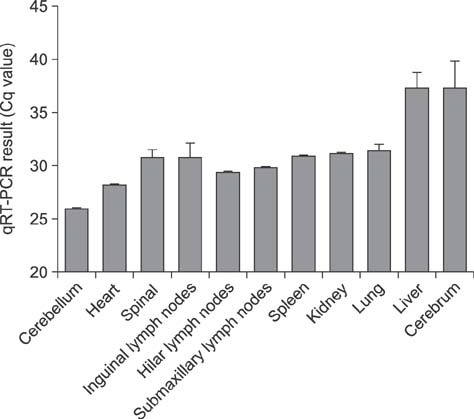J Vet Sci.
2018 May;19(3):468-471. 10.4142/jvs.2018.19.3.468.
Identification and characterization of atypical porcine pestivirus genomes in newborn piglets with congenital tremor in China
- Affiliations
-
- 1College of Animal Science & National Engineering Center for Swine Breeding Industry, South China Agricultural University, Guangzhou 510642, China. cxsong2004@163.com
- KMID: 2412138
- DOI: http://doi.org/10.4142/jvs.2018.19.3.468
Abstract
- Recently, a novel atypical porcine pestivirus (APPV) in pig was reported. In this study, two APPV strains, APPV-China/GZ01/2016 (GZ01) and APPV-China/GD-SD/2016 (GD-SD), were identified in two newborn piglet herds with congenital tremor from China. The open reading frame of the two strains shared an 83.5% nucleotide identity. Phylogenetically, the APPV strains were placed into two groups: GZ01 belonged to group I and GD-SD belonged to group II. A high viral load was detected in the cerebellum (quantification cycles < 26). Further studies should be carried out to thoroughly elucidate the development of congenital tremors caused by APPV.
MeSH Terms
Figure
Reference
-
1. Arruda BL, Arruda PH, Magstadt DR, Schwartz KJ, Dohlman T, Schleining JA, Patterson AR, Visek CA, Victoria JG. Identification of a divergent lineage porcine pestivirus in nursing piglets with congenital tremors and reproduction of disease following experimental inoculation. PLoS One. 2016; 11:e0150104.
Article2. Beer M, Wernike K, Dräger C, Höper D, Pohlmann A, Bergermann C, Schröder C, Klinkhammer S, Blome S, Hoffmann B. High prevalence of highly variable atypical porcine pestiviruses found in Germany. Transbound Emerg Dis. 2017; 64:e22–e26.
Article3. de Groof A, Deijs M, Guelen L, van Grinsven L, van Os-Galdos L, Vogels W, Derks C, Cruijsen T, Geurts V, Vrijenhoek M, Suijskens J, van Doorn P, van Leengoed L, Schrier C, van der Hoek. Atypical porcine pestivirus: a possible cause of congenital tremor type A-II in newborn piglets. Viruses. 2016; 8:pii: E271.
Article4. Done JT, Harding JD. Congenital tremor in pigs (trembling disease of piglets): lesions and causes. Dtsch Tierarztl Wochenschr. 1967; 74:333–336. German.5. Firth C, Bhat M, Firth MA, Williams SH, Frye MJ, Simmonds P, Conte JM, Ng J, Garcia J, Bhuva NP, Lee B, Che X, Quan PL, Lipkin WI. Detection of zoonotic pathogens and characterization of novel viruses carried by commensal Rattus norvegicus in New York City. MBio. 2014; 5:e01933–e01914.
Article6. Hause BM, Collin EA, Peddireddi L, Yuan F, Chen Z, Hesse RA, Gauger PC, Clement T, Fang Y, Anderson G. Discovery of a novel putative atypical porcine pestivirus in pigs in the USA. J Gen Virol. 2015; 96:2994–2998.
Article7. Kirkland PD, Frost MJ, Finlaison DS, King KR, Ridpath JF, Gu X. Identification of a novel virus in pigs—Bungowannah virus: a possible new species of pestivirus. Virus Res. 2007; 129:26–34.
Article8. Kumar S, Stecher G, Tamura K. MEGA7: Molecular Evolutionary Genetics Analysis version 7.0 for bigger datasets. Mol Biol Evol. 2016; 33:1870–1874.
Article9. Larkin MA, Blackshields G, Brown NP, Chenna R, McGettigan PA, McWilliam H, Valentin F, Wallace IM, Wilm A, Lopez R, Thompson JD, Gibson TJ, Higgins DG. Clustal W and Clustal X version 2.0. Bioinformatics. 2007; 23:2947–2948.
Article10. Postel A, Hansmann F, Baechlein C, Fischer N, Alawi M, Grundhoff A, Derking S, Tenhündfeld J, Pfankuche VM, Herder V, Baumgärtner W, Wendt M, Becher P. Presence of atypical porcine pestivirus (APPV) genomes in newborn piglets correlates with congenital tremor. Sci Rep. 2016; 6:27735.
Article11. Schwarz L, Riedel C, Högler S, Sinn LJ, Voglmayr T, Wöchtl B, Dinhopl N, Rebel-Bauder B, Weissenböck H, Ladinig A, Rümenapf T, Lamp B. Congenital infection with atypical porcine pestivirus (APPV) is associated with disease and viral persistence. Vet Res. 2017; 48:1.
Article12. Wang PP, Dong JG, Zhang LY, Liang PS, Liu YL, Wang L, Fan FH, Song CX. Sequence and phylogenetic analyses of the Nsp2 and ORF5 genes of porcine reproductive and respiratory syndrome virus in boars from South China in 2015. Transbound Emerg Dis. 2017; 64:1953–1964.
Article13. Wu Z, Ren X, Yang L, Hu Y, Yang J, He G, Zhang J, Dong J, Sun L, Du J, Liu L, Xue Y, Wang J, Yang F, Zhang S, Jin Q. Virome analysis for identification of novel mammalian viruses in bat species from Chinese provinces. J Virol. 2012; 86:10999–11012.
Article14. Yuan J, Han Z, Li J, Huang Y, Yang J, Ding H, Zhang J, Zhu M, Zhang Y, Liao J, Zhao M, Chen J. Atypical porcine pestivirus as a novel type of pestivirus in pigs in China. Front Microbiol. 2017; 8:862.
Article15. Zhang K, Wu K, Liu J, Ge S, Xiao Y, Shang Y, Ning Z. Identification of atypical porcine pestivirus infection in swine herds in China. Transbound Emerg Dis. 2017; 64:1020–1023.
Article
- Full Text Links
- Actions
-
Cited
- CITED
-
- Close
- Share
- Similar articles
-
- Porcine epidemic diarrhea: a review of current epidemiology and available vaccines
- Selection of a Less Pathogenic BVDV Strain for the Construction of Avirulent Chimeric Pestivirus
- Prevalence and pathologic study of porcine epidemic diarrhea in Jeju
- Sequence analysis of the spike gene of Porcine epidemic diarrhea virus isolated from South China during 2011–2015
- Development of a multiplex qRT-PCR assay for detection of African swine fever virus, classical swine fever virus and porcine reproductive and respiratory syndrome virus



